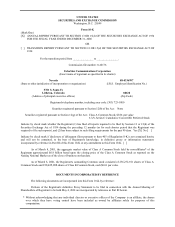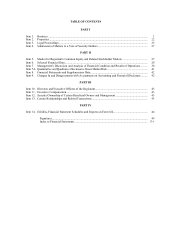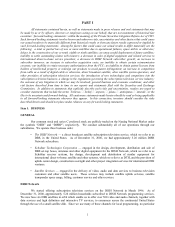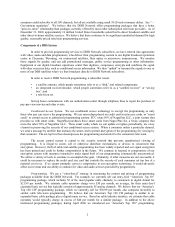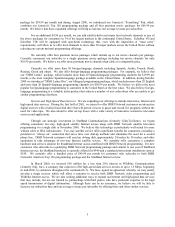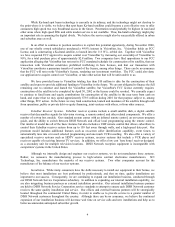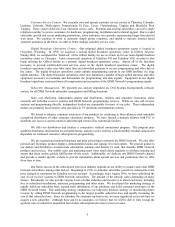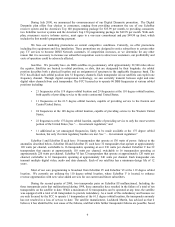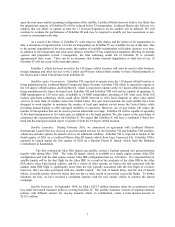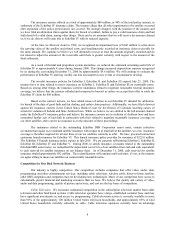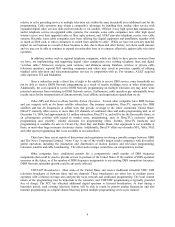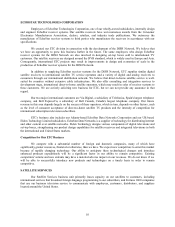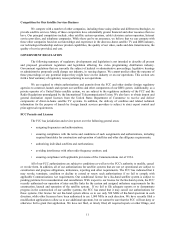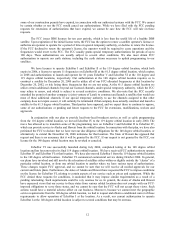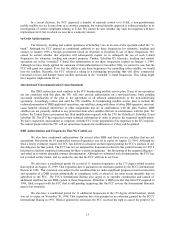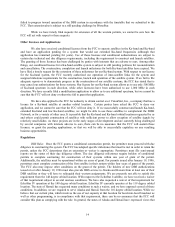Dish Network 2000 Annual Report Download - page 9
Download and view the complete annual report
Please find page 9 of the 2000 Dish Network annual report below. You can navigate through the pages in the report by either clicking on the pages listed below, or by using the keyword search tool below to find specific information within the annual report.7
upon the root cause and the operating configuration of the satellite, Lockheed Martin does not believe it is likely that
the operational capacity of EchoStar III will be reduced below 32 transponders. Lockheed Martin also believes it is
unlikely that our ability to operate at least the 11 licensed frequencies on the satellite will be affected. We will
continue to evaluate the performance of EchoStar III and may be required to modify our loss assessment as new
events or circumstances develop.
As a result of the failure of EchoStar IV solar arrays to fully deploy and the failure of 28 transponders to
date, a maximum of approximately 14 of the 44 transponders on EchoStar IV are available for use at this time. Due
to the normal degradation of the solar arrays, the number of available transponders will further decrease over time.
In addition to the transponder and solar array failures, EchoStar IV has experienced anomalies affecting its thermal
systems and propulsion system. Consequently, the total remaining useful life of EchoStar IV is currently
approximately three years. There can be no assurance that further material degradation, or total loss of use, of
EchoStar IV will not occur in the immediate future.
EchoStar I, which has been moved to the 148 degree orbital location, will soon be used to offer business,
foreign language and other services to the Central and Western United States similar to those offered primarily to
the Eastern and Central United Sates from EchoStar III.
Satellites under Construction. EchoStar VII, expected to operate from the 119 degree orbital location, is
being manufactured by Lockheed Martin Commercial Space Systems. EchoStar VIII, which is expected to operate at
the 110 degree orbital location, and EchoStar IX, which is expected to operate at the 121 degree orbital location, are
being manufactured by Space Systems/Loral. EchoStar VII and EchoStar VIII will each be capable of operating 32
DBS transponders at 120 watts each, switchable to 16 DBS transponders operating at 240 watts each. Both will
include spot-beam technology which could allow DISH Network to offer local channels or other value added
services in more than 30 markets across the United States. The spot beam payloads for each satellite have been
designed to work together to maximize the number of local spot markets served across the United States, while
providing mutual backup to offer increased reliability to customers. However, use of spot beams will reduce the
number of transponders that can be used to provide nationwide coverage. EchoStar IX will be capable of operating
32 Ku-band transponders at 110 watts each, in addition to a Ka band payload. We also expect in the near future to
commence the construction phase for EchoStar X. We expect that EchoStar X will have a combined C-band, Ku-
band and Ka-band payload and expect to operate it from the 83 degree orbital location.
Satellite Launches. During February 2001, we announced an agreement with Lockheed Martin’s
International Launch Services division to provide launch services for the EchoStar VII and EchoStar VIII satellites,
which also includes options for launch services for additional satellites. EchoStar VII is expected to launch in the
fourth quarter of 2001 on a Lockheed Martin Atlas III launch vehicle from Cape Canaveral, Fla. EchoStar VIII is
expected to launch during the first quarter of 2002 on a Russian Proton K launch vehicle from the Baikonur
Cosmodrome in Kazakhstan.
The first commercial Atlas IIIA launch successfully carried a Eutelsat payload into geosynchronous
transfer orbit during May, 2000. The Atlas III launch vehicle is available in a single engine centaur Atlas IIIA
configuration and with the dual engine centaur Atlas IIIB configuration that we will utilize. It is expected that our
satellite launch will be the first flight for the Atlas IIIB. As a result of the similarity of the Atlas IIIB to the Atlas
IIIA and to other Atlas launch vehicles, and for a variety of other reasons, we believe the risk associated with the
maiden Atlas IIIB flight is significantly lower than the risk typically associated with the first flight of a rocket.
However, there are risks associated with any satellite launch. The risk of launch delay, and the risk of launch
failure, is usually greater when the rocket does not have a track record of previously successful flights. To further
minimize the risk, we have retained a consultant familiar with the new launch vehicle to monitor the launch
campaign.
Satellite Insurance. In September 1998, we filed a $219.3 million insurance claim for a constructive total
loss under the launch insurance policies covering EchoStar IV. The satellite insurance consists of separate identical
policies with different carriers for varying amounts which, in combination, create a total insured amount of
$219.3 million.

